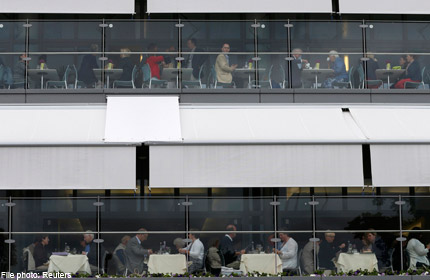
If you still associate British food with gravy from an Oxo stock cube and boiled-till-grey vegetables, you will be surprised to learn that London is now one of the food capitals of the world.
In fact, MasterChef judge and two-Michelin-starred chef Michel Roux Jr thinks it superior to Paris, New York and Tokyo in one respect: it also has first-class ethnic restaurants.
"You can't get a decent curry in Paris - you can get a great curry at cheap prices in London, or a fine-dining curry in London," he told a London newspaper.
Of Michelin-starred ethnic restaurants, there are seven Indian and three Chinese, all superb. But there are also countless unstarred but excellent Japanese, Moroccan, Mexican, Spanish and Italian establishments.
Some foodie friends who were in London recently ate at a tiny Japanese sushi bar that they rated as good as the Singapore branches of Tokyo's Michelin-starred restaurants, while together we ate at Lima, a Peruvian restaurant, which was brilliant.
But while restaurants like these can only thrive if there is demand for them from a more adventurous and discerning public, the true measure of a country's cuisine is of course its own food.
This is where the near-miracle has taken place: British food has improved. Immeasurably.
The truth is, the corned beef and tinned peas diet so sniggeringly associated with British cuisine was the result of the impact of World War II on food production.

What many people do not realise is that rationing then continued, even after the end of the six-year war, right up to 1954. On July 4 that year, after 14 years of rationing, there was a name for the date - Derationing Day - which the London Housewives Association celebrated with a special ceremony in Trafalgar Square.
Since last week, Britain has entered its 60th year since rationing ended. This country could not be more different. For instance, public houses or "pubs" - those ubiquitous bastions of British life - used to be famous for their ales but not their food. In many, the best you could hope for, other than pickled eggs from a jar, was a bag of potato crisps.
Now many of these places have remade themselves into so-called "gastropubs" which proudly describe themselves as serving British food. What you are more than likely to find are perfectly cooked English asparagus with chive butter, topped with a well-judged poached duck's egg, or chargrilled English poussin (small chicken to you), with purple sprouting broccoli, wild garlic and rosemary potatoes.
Eating out in Britain has transformed nearly beyond recognition, mainly in the last 10 years. But it would be wrong to think of this as a revolution so much as a rediscovery.
The 20th-century British ate badly out of necessity, then habit, not choice - but their forebears were no slouches on the foodie front.
Elizabethans were known for their extravagant feasts of roast peacock, swan and blackbirds as well as joints of veal, kid, beef and lamb followed by sculptures from marzipan and sugar of fruit baskets and little animals or birds.
Later, during Jane Austen's time, in the Regency period, French cooks began to infiltrate the houses of the rich after their patrons in France ended on the guillotine. Spit-roasted meat was now presented with French flair, along with magnificent pies and quiches, and shimmering jellies and ices turned into exquisite shapes using intricate moulds.
But the rationing that was briefly introduced in World War I and which became entrenched during World War II changed all that.
It really took till 1998 before Delia Smith's How to Cook television series brought about a widespread revival of interest in food and cooking. Smith famously took nothing for granted with her viewers' culinary skills, teaching even basics like how to properly boil an egg.
Children of the women who were her fans then had the laidback Jamie Oliver for their role model, followed by the wildly experimental Heston Blumenthal, whose molecular gastronomy won as many fans among older, beardy blokes as the young.
Underpinning this interest in cooking well is Britons' love of gardening and growing vegetables on their allotments. The connection between treating with respect what you grow and how you cook it is at last being remade.
Heritage breeds of pigs and cattle, and heritage strains of carrot and apples are now reclaimed with enthusiasm, which makes it wonderful for the ordinary consumer like me.
The organic box of vegetables that I had delivered to my house this week includes pearl red onions and wild samphire, a coastal or estuarine plant ignored till about 10 years ago.
And I can think of no other place in the world where you can buy wild rocket, tea-smoked salmon, buffalo mozzarella, baby plum tomatoes on the vine, goat's butter, organic creme fraiche or wild-boar salami as a matter of course from a supermarket. Even at the cut-price Tesco's.
Nowadays, you can, if you want, affect boredom with the "good produce simply cooked" ethos after innumerable plates of beautifully pan-fried cod or hunks of steak from grass-fed native Hereford cattle.
But I have lived in Britain since 1992 and eaten through the final dark days of brown sauces sticky as glue or, worse, attempts at "creative" fusion where tinned pineapple might be mixed with sugary chilli sauce from a bottle and slopped over strips of turkey. I will not be complaining.
The writer is a Singaporean based in London.

